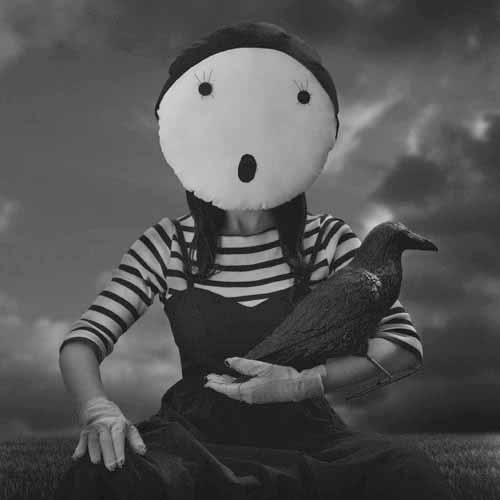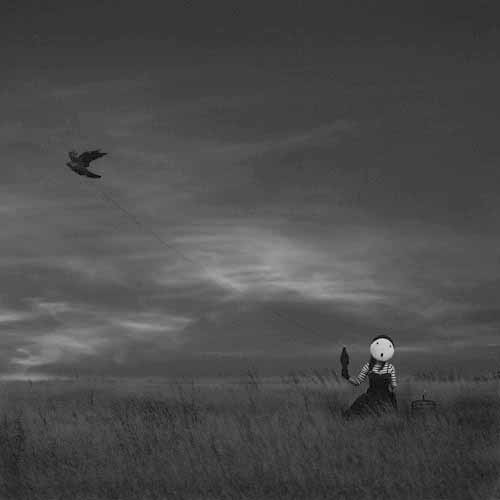

The Thoughtplay

IX Scary Dresses
Fear has well settled in us,
it accompanies us
during our everyday toil and does
not necessarily need new external impulses
because the actions to which it leads
provide enough motivation and energy each day in order
for our fear to reproduce.
it accompanies us
during our everyday toil and does
not necessarily need new external impulses
because the actions to which it leads
provide enough motivation and energy each day in order
for our fear to reproduce.
Zygmunt Bauman, Liquid Times. Living in an Age of Uncertainty
The answer to the question "What is Roman's and Zaranek's series about?" is not easy. Looking at these photographs we instinctively attempt to put them together into a story, into a classical, linear narrative. However, our efforts are bound to fail. That is because FiFi is closer to the paradoxical narrative of myths than to a story of a logical, cause-and effect structure. Strong saturation of their images with symbols opens the latter up to a virtually limitless number of interpretations. Unlike allegory, symbol is an open, paradoxical structure, in which meanings may be contradictory although the symbol itself remains an entity. Our first encounter with FiFi makes us think of various interpretations in the spirit of C.G. Jung, of archetypes of womanhood 3 and of the process of individuation - but it may also be a fable devoted to an identity crisis.
As a piece of literature the fable is closely related to myth as narrative. Ryszard Tomicki defines myth as a story about gods and their exploits, about the beginning of the world and man, and about the origins of all things, phenomena and institutions4 . Włodzimierz Propp, a Russian scholar who studied both the morphology and genesis of wonder tales or fables, shares this opinion and believes that formally speaking myth is no different than a fable. Fable and myth, especially myths of primitive, still classles peoples, sometimes can be similar to such an extent that ethnography and folklore studies even call myths fables5 . Originally myth and fable were closely connected with various rituals. The question which came first, the ritual or the story, probably can never be answered, though scholars of religion have been arguing about what was first ever since their discipline has been established. Propp without answering the question claims that myth and wonder fables should be associated with inititiaton rites. In traditional societies initiation mysteries shaped the identity of people who took part in them and revealed for them the meaning of life and culture. They engulfed the individual in a meaningful nomos. FiFi, a postmodern fable, shows the fragmentization of the ego, the initiation into a culture in which the only certain things are fear and death.
In the FiFi series we can find two works called Countenance 1 and Countenance 2. Their heroine/model reveals her heart before us and her mood keeps swinging between extreme emotions. From the phenomenological point of view these photos may be treated as a kind of visualization of moments of different phases of self-identification. The unstable image people have of themselves, the motif of the mask, the emotional instability and the feeling of loss present in Roman's and Zaranka's photographs cause FiFi to be treated as a so-called "borderline" personality. Telling are also works called 9 Terrible Dresses and The Play of Thoughts. On the one hand they can be seen as the manifestation of our struggle with our own identity in an attempt to accomplish firm self-identification. On the other hand, however, they suggest that such an ambition can never be fulfilled, among other reasons because of the dynamics of human emotions and the post-traditional model of society which demands that we play many different roles in the theatre of our daily routine, as Erving Goffman puts it while Anthony Giddens claims that modern times do not favour internal narratives and that modern societies have become aware of the fact that identities are never stable. Identity always means a process of building, putting together and finally guarding our internalized vision of ourselves which we managed to achieve with such effort. In order for this vision to be convincing, the truth about the uncertain status of identity must be displaced and laboriously hidden7 . FiFi de-mythicizes the postulate of the internal integrity of the ego and shows that it is a process.
The semantic complexity of the staged works by Roman and Zaranek is created mainly by the props with which they surround their heroine. We usually associate such objects with primitive cultures: a stone, an egg, a bird. The authors also allude to Christian iconography (the motif of the Last Supper in Feedbox). Our attention is drawn for example by a crow-like bird that repeatedly appears in the pictures. The meaning of the crow is ambiguous: his biological features (like black feathers) point to the chtonic sphere of the other world while his liking of sparklers makes it a solar bird. The birds of this genus also play the role of a mediator who transgresses the opposition of dead/living that can be also seen in the Christian Last Supper. Reading these photographs as a contemporary fable we can dare say that they speak about the process of initiation into one's own ego or self. Therefore they also allude to the wonder fable of preindustrial societies whose existence must be, according to Propp, associated with initiation rites. However, it is not a universal story but a story strongly rooted in its "here and now". The fable is the product of its times. And that is also how the Russian scholar conceived his wonder fable: as a reflection of real, economic, historical and social conditions. The functions of the fable in Propp's opinion are purely utilitarian and serve communication. FiFi is a utilitarian fable inasmuch it points to cultural arguments over such notions as "ego" or the "self", "identity" and "individualism". The meaning of those images is rather pessimistic, like the conclusions of sociologists who are trying to describe the condition of contemporary culture. Even Emil Durkheim noticed long ago that the collapse of the sacred marquee of meaning - the result of moving from traditional to modern types of society - introduced the phenomenon of so-called anomia which is the inability of producing a coherent system of norms and values that can clearly tell one what to do. In his work called Suicide: A Study in Sociology, fundamental for suicidology, Durkheim calls one of the types of suicide anomic. The problem of anomia is born of the absence of holistic visions of the world and that is why the postmodern world cannot be thought of as coherent - because it undergoes de-universalization and becomes enthropic . The fact that FiFi experiences fears and constant internal struggles is confirmed by the titles of the works: Insomnia, Despair, The Play of Thoughts, 9 Terrible Dresses, Rejected. It seems that this series could be shown under the title/slogan Anda Rottenberg used for one exhibition: POSTINDUSTRIAL SORROW.
The aesthetics of FiFi prove that the authors are fascinated by the art of Tim Burton and that they managed to produce works full of the eeriness of a dark fable. As a whole, however, their series is neither dark nor pessimistic. It has in it something of the decadent delight over the unsocialized and lunar element in man, something of the oscillation between affirmation and negation. At the same time those photographs can be seen as an attempt at the rationalization and objetivization of internal experience. Theatricalization of images in the photographs by Roman and Zaranek, while creating distance towards the represented reality, inspire the viewers to try and decipher the meanings hidden in them...
Przemysław Chodań
2Georg Simmel, Most i drzwi [Bridge and Door], Oficyna Naukowa, Warsaw 2008, p. 87.
3Roma Roman explored the problem of womanhood for example in her Covers of Womanhood (the BB gallery, Cracow 2004) and in (Un)cover Your Womanhood (the BB gallery, Wrocław 2005).
4See Andrzej Szyjewski, Etnologia religii [Ethnology of Religion], Zakład Wydawniczy Nomos, Cracow 2008, p. 79.
5Włodzimierz Propp, Historyczne korzenie bajki magicznej [The Historical Roots of the Wonder Tale], Wydawnictwo KR, Warsaw 2003, pp. 19-20.
6Por. Anthony Giddens, Przemiany intymności. Seksualność, miłość i erotyzm we współczesnych społeczeństwach [The Transformation of Intimacy. Sexuality, Love and Eroticism in Modern Societies], Państwowe Wydawnictwo Naukowe, Warsaw 2006.
7Zygmunt Bauman, Tożsamość. Rozmowy z Benedetto Vecchim [Identity. Conversations with Benedetto Vecchi], Gdańskie Wydawnictwo Psychologiczne, Gdańsk 2007, p. 18.
8Andrzej Szyjewski, Kruk [in:] Encyklopedia Religii PWN [Encyclopedia of Religion], vol. 6, Tadeusz Gadacz, Bogusław Minerski eds., PWN, Warsaw 2006
9See Dominika Motak, Ponowne zaczarowanie świata: pomiędzy transcendencją, immanencją a utopią [The World Enchanted Again: Between Transcendence, Immanence and Utopia [in:] Światopogląd: między transcendencją a codziennością [Worldview: Between Transcendence and Everyday Life, Irena Borowik, Henryk Hoffmann, eds,. Zakład Wydawniczy Nomos, Cracow 2004

The Despair

The Cardle

Countenance

The Losscreature

The Rejected
Next exhibition
11-30 VI 2010
Copyright ©2010 Galeria FF ŁDK, Roma Roman, Bartłomiej Zaranek, Przemysław Chodań